This is a very elegant soup, often served in Kaiseki ryōri (traditional Japanese multi-course haute cuisine). It might look technically difficult, but actually it is quite easy to make. Shrimp Balls (Ebi-shinjo) are made of fresh prawns/shrimp and fish cakes with seasonings. They are simply boiled and served in Clear Soup.
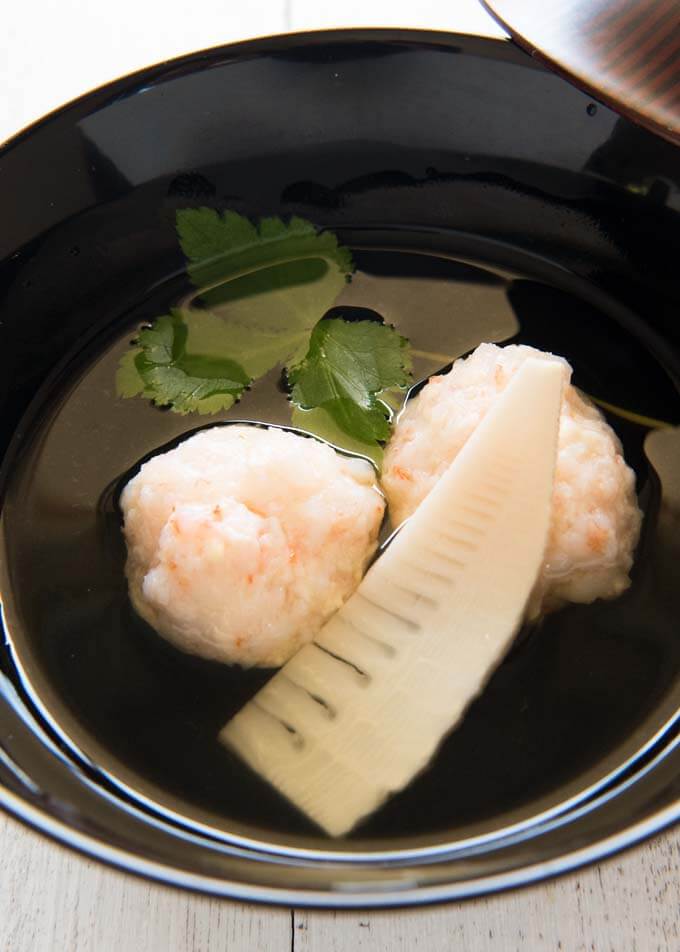
If you want to show off to your diners with a Japanese meal, I’d strongly recommend serving Shrimp Balls in Clear Soup. Light and delicate flavour, impressive presentation – what more would you need? And it’s quick to make.
About Shinjo
Balls made from white flesh fish or shellfish such as prawns or crabs are called ‘shinjo’ (しんじょ) or ‘shinjō’ (しんじょう) in Japanese cuisine. The real shinjo is made by mixing white fish/shellfish paste, grated Japanese mountain yam, a bit of sake and salt, and sometimes egg white and/or corn flour to bind the ingredients.
Regardless of the type of fish/shellfish used to make the balls, they are generically called ‘shinjo’. And if shinjo is made with prawns/shrimps like today’s recipe, it becomes ‘ebi-shinjo’ (海老しんじょ) meaning prawn-shinjo/shrimp-shinjo, because ‘ebi’ (海老) is prawn/shrimp.
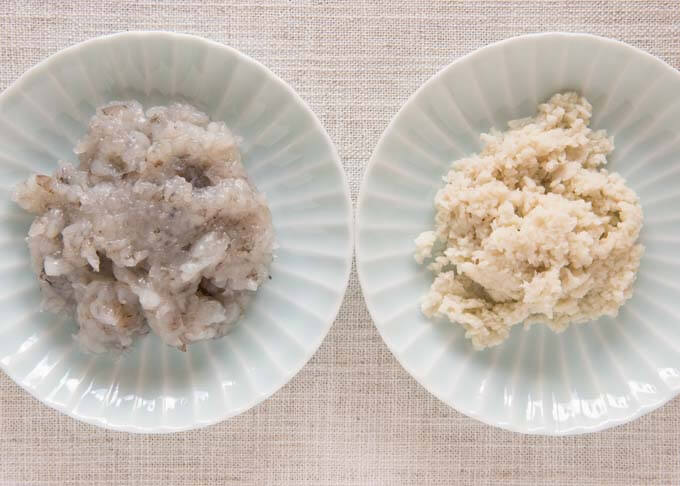
The cooking method can also vary. I cooked the shinjo in the easiest way, that is, simply to boil it. But you can deep fry, steam, pan fry, grill, etc. and they are all called shinjo.
Shrimp Balls (Ebi-shinjo) Ingredients
My Ebi-shinjo are made of prawns, a fish cake called ‘hanpen’ (はんぺん), a bit of sake, ginger, salt and corn flour. I substituted mountain yam with hanpen fish cake because mountain yam is impossible to find in Sydney and hanpen is made of fish paste and Japanese mountain yam (= good substitute).
If hanpen is not easy to find, you can make Ebi-shinjo without it. I included in the recipe instructions how to make Shrimp Balls without hanpen.
About Hanpen
Hanpen looks like the photo below. You can buy it frozen at Japanese grocery stores.

The texture of hanpen is spongy when defrosted and it is almost like hard soufflé. In Japan, hanpen is often included in Oden as one of the stewing ingredients, although my Oden (Simmered One Pot Dish) did not have it.
When I stay at my sister’s place in Tokyo, she sometimes serves me grilled hanpen. Just grill it, cut into quarters, then eat with a bit of soy sauce. Simple but delicious.
Texture of Shrimp Balls
Some Ebi-shinjo has a very smooth texture but some retains small prawn bits in the ball to give a bit of prawn texture.
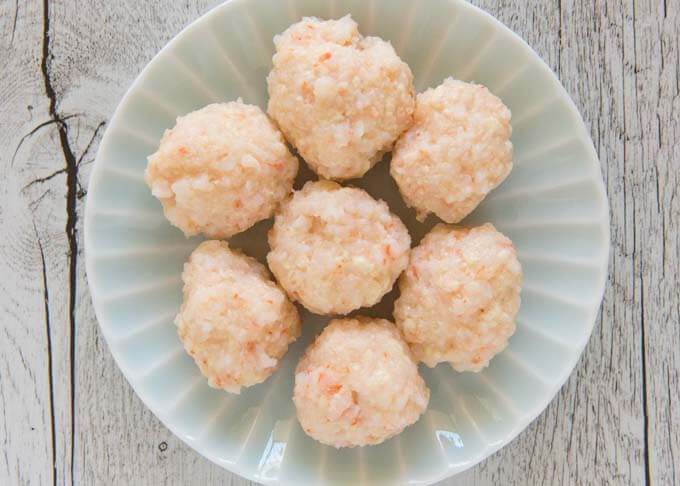
Ebi-shijo with small prawn meat. You can see the bumpy surface. (There should be 8 of them but I ate one before taking this photo. Sorry!)
I tried both textures. I used a food processor to make smooth Ebi-shinjo. Mix all the ingredients in the food processor and make shrimp paste.
The other shinjo texture does not require a food processor. All you need is a cooking knife and a cutting board. Dice the prawns into small pieces and spread the prawn pieces thinly on the cutting board.
Starting from one end of the mince, chop the mince in a methodical way by moving the knife 5-7mm / ¼” to the other end. Then do the same perpendicular to the first direction. You should get a pretty pasty mince with tiny pieces of prawns. Mix the prawn paste with the other ingredients.
I used the latter method today and I like the idea of leaving a bit of prawn texture. In either method, the paste becomes quite sticky. Wet your hands when making a ball.
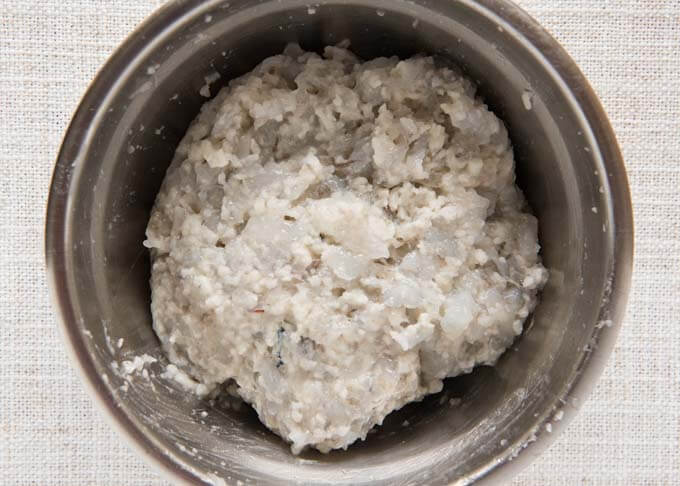 Clear Soup
Clear Soup
Ebi-shinjo is quite a delicate food. When boiled, it shows the bright orange from the minced prawns here and there in the white balls. To show off the beautiful colours of the Shrimp Balls, the soup must be a clear soup.
Japanese clear soup is called ‘osuimono’ (お吸い物). It is a very simple soup made from good dashi stock, light soy sauce, sake and salt. It is meant to highlight the flavour of dashi stock and the ingredients in the soup.
I used a wide and shallow soup bowl so that the soup did not completely cover the Ebi-shinjo in the bowl. I think that you can even serve it in a traditional Western-style soup bowl.
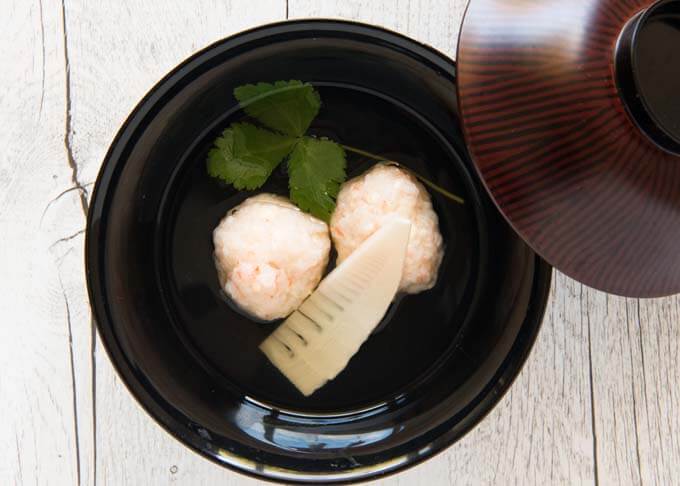
Yumiko![]()
PS: I added a new section ‘MEAL IDEAS’ below the recipe card. It gives you a list of dishes that I have already posted and the new recipe in this post that can make up a complete meal. I hope it is of help to you!
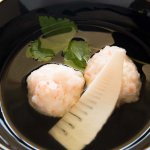
This is a very elegant soup. It is often served in Kaiseki Ryōri, but it’s surprisingly quite easy to make. Simply mix prawn paste and hanpen fish cakes with seasonings, make balls and boil them before serving in clear soup.
- 150g/5.3oz fresh or frozen prawn/shrimp without shells , deveined and finely minced (note 1)
- 1 hanpen fish cake , very finely diced (60g/2.1oz, note 2)
- 1 tsp sake
- ¼ tsp juice from grated ginger
- 1 tbsp cornflour/corn starch
- A pinch of salt
- 800ml/1.7pt dashi stock (note 3)
- 2 tsp light soy sauce
- 2 tsp sake
- ⅔ tsp salt
- 4 bamboo shoot slices , boiled
- 4 mitsuba (note 5)
-
Add the Clear Soup ingredients to a saucepan and heat it up. When it starts boiling, add bamboo shoot slices and cook for a minute or so. Turn the heat off.
-
Place the diced hanpen on the cutting board. Using the side of a knife, press the hanpen pieces down to crush them, making them into paste like texture.
-
Add the prawn, hanpen and the rest of Ebi-shinjo ingredients in a bowl and mix well.
-
Divide the prawn mixture into 8 equal portions. Wet your hands and make a ball from 1/8 of the prawn mixture. Repeat and make 8 balls.
-
Fill a medium size pot with water to a depth of about 10cm/4” and heat over high heat (note 6).
-
When the water starts boiling, drop balls one by one into the boiling water.
-
After the ball starts floating, cook about 2 minutes and transfer to a plate.
-
Reheat the Clear Soup, place two Shrimp Balls per serving bowl and add equal amount of soup to the bowls.
-
Place a bamboo shoot slice and a mitsuba in each bowl. Serve immediately.
1. Dice the prawns into very small pieces and spread the prawn pieces thinly on the cutting board. Starting from the one end of the mince, chop the mince in a methodical way by moving the knife by 5-7mm / ¼”, then do the same perpendicular to the first direction.
Instead of mincing the prawns by hand, you can use a food processor to make paste. In this case, add all the Shrimp Balls ingredients to the food processor and make shrimp paste. You can then skip the steps 2 & 3.
2. Hanpen is made of fish paste and Japanese mountain yam with seasoning (see the photo in my post). It is sold frozen at Japanese grocery stores.
If you can’t get hanpen, omit it and increase the amount of prawn by 50g/1.8oz, add ½ teaspoon sugar and increase salt by another pinch.
3. When the dashi stock is one of the key features of the dish like today, I use ichiban-dashi (see Home Style Japanese Dashi Stock) as it has the best flavour.
But if you have no time to make dashi stock from scratch, you can use a dashi pack to make clear soup. Please refer to the instructions on the pack and use the appropriate quantity of dashi pack for the dashi stock required in the recipe.
4. Thinly sliced bamboo shoots and mitsuba leaves are my choice today. But you can substitute them with other vegetables such as sliced shiitake mushrooms, shimeji mushrooms, or sliced carrot. They need to be blanched in the Clear Soup.
Instead of mitsuba, you can use other green leaves such as small mizuna leaves, blanched spinach, snow pea shoots or julienned blanched snow peas.
5. Mitsuba is a wild Japanese parsley or the Japanese version of Cryptotaenia. Japanese grocery stores usually stock fresh mitsuba. But in Sydney Korean grocery stores may sell mitsuba, too.
6. Instead of boiling Shrimp Balls in a separate saucepan of boiling water, some recipes boil them in the Clear Soup directly. It reduces washing but I didn't use this method because the shrimp balls tend to make the clear soup a little bit cloudy. If you don’t mind a cloudy soup, you can cook the balls directly in the clear soup.
7. Nutrition per serving. It does not include garnish.
serving: 120g calories: 71kcal fat: 2.2g (3%) saturated fat: 0.5g (2%) trans fat: 0g polyunsaturated fat: 0.4g monounsaturated fat: 0.9g cholesterol: 56mg (19%) sodium: 937mg (39%) potassium: 188mg (5%) carbohydrates: 3.2g (1%) dietary fibre: 0.3g (1%) sugar: 0.1g protein: 8.4g vitamin a: 1.9% vitamin c: 1.5% calcium: 1.9% iron: 1.3%
Meal Ideas
A typical Japanese meal consists of a main dish, a couple of side dishes, a soup and rice. I try to come up with a combination of dishes with a variety of flavours, colours, textures and make-ahead dishes.
I thought of listing suitable dishes to make up a meal that resembles Kaiseki ryōri. But it would require 9 dishes, which is too many. So, I picked dishes that can be served in Kaiseki ryōri but reduced it to 5 items. I will one day post a home-made Kaiseki ryōri.
- Main: Chikuzenni (Simmered chicken and Vegetables) as main – make ahead except snow peas, blanch snow peas on the day.
- Side dish 1: Japanese Fried Tofu (Agedashi Tofu) – make sauce the day before.
- Side dish 2: Chawanmushi (Savory Egg Custard) – you could prepare the ingredients to go into chawanmushi the day before.
- Soup: Shrimp Balls (Ebi-shinjo) in Clear Soup – today’s recipe.
- Rice: Rice with White Radish (Daikon Takikomi Gohan)
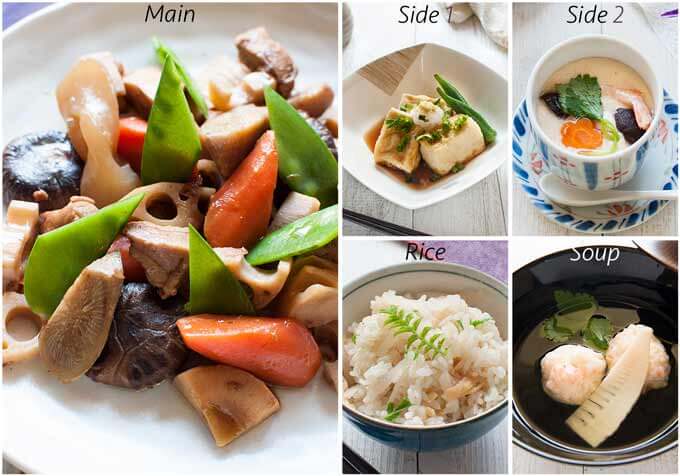
Excellent! Thank you — extremely useful.
With love from the U.S.! Happy 2024!
– Linda
Hi Inda, thank you and Happy New Year!
thank you so much yumiko keep up the good work
Hi Ken, thank you!
Hi, Yumiko,
I love reading your recipes! I was lucky enough to visit Japan three times and I truly love it there.
Every one of your recipes includes sake and/or mirin. I am a recovering alcoholic and cannot have sake in my home since I love it and it is too big of a temptation. Is there anything I can use as a substitute that will in some way mimic the flavor?
Thank you so much!
Donna
Hi Donna, it is a bit difficult to completely replace sake with non-alcohol seasoning. However, if the amount required is small such as this recipe, you can add water or just omit it. With regard to a substitution for mirin, there is non-alcoholic mirin (https://www.amazon.com/Honteri-Non-alcoholic-Mirin-Sweet-Seasoning/dp/B00IFW3X9A) and if you can purchase it, that would be the easiest. If not, use water with 1/3 tablespoon of sugar in place of 1 tablespoon mirin.
If the dish requires a large amount of sake such as Sakamshi Fish (https://japan.recipetineats.com/sakamushi-fishi-steamed-fish-in-sake/), it is unfortunately not easy to substitute with something else.